***Many spoilers ahead for The Witcher: Nightmare of the Wolf***
The animated Netflix movie The Witcher: Nightmare of the Wolf is quite watchable if you don’t mind intensely drawn violence and gore. Clocking in at 83 minutes, the plot is a bit of a mess, but most of us don’t tune into Witcher fare for cold hard logic.
This is a brutal and complicated fantasy realm based on Andrzej Sapkowski’s bestselling series of novels, further informed by the action of the popular Witcher video games and the runaway success of the first season of the live-action Witcher TV adaptation.
Nightmare of the Wolf serves as a kind of prequel to the forthcoming second season of The Witcher. It’s the origin story of Vesemir, a powerful, cocky, wry Witcher who later becomes young Geralt’s mentor. We’ll meet live-action Vesemir (played by Killing Eve’s excellent Kim Bodnia) in season 2, presumably when Geralt takes Ciri to the now-ruined Witcher stronghold of Kaer Morhen for training. Nightmare of the Wolf shows us how Vesemir (voiced by Theo James) got there from a hardscrabble youth, the horrors of his Witcher upbringing, and what went down to destroy Kaer Morhen and decimate its Witcher population.
Nightmare of the Wolf flashes back and forth from Vesimir at 70 (he’s still youthful in appearance, as Witchers age at a slower rate and can live hundreds of years) to Vesemir as an adolescent. There’s a love story there that’s central to the plot and rather well done, but the most impactful element of the movie is in its detailed depiction of Witcher training.
It’s, well, an absolute nightmare of a process, in which boys are subject to trials of both monster-fighting and torturous magical scientific experimentation. Only a handful survive, but it’s this ghastly gauntlet of an “education” that ensures Witchers are capable of great physical and arcane feats.
Vesemir has a few friends in his training group, one of whom, Luka, makes it through with him. Luka (voiced by Matthew Yang King), like seemingly all Witchers we’ve met, is confident, foul-mouthed, and sarcastic. He is also queer, the first time we’ve heard mention of queerness in the Netflix Witcher properties.
(There may have been some background queer pairings in the mass orgy scene when Geralt first meets Yennefer, but those people were all under Yennefer’s spell. In the video games, a few characters are shown to be queer, including Ciri, whose sexuality in the novels is a matter of great debate online. The Netflix series glaringly lacked queer representation, since those Jaskier/Geralt “gay undertones” don’t count canonically.)
When we encounter the adult Luka in Nightmare of the Wolf, he’s complaining about the lack of business in the Witcher world and his haul of coins versus Vesemir’s. “Meanwhile, I hardly made enough to score a night with a limp-pricked man-whore,” Luka laments.
Vesemir acts as though this sort of statement is par for the course for his friend. “You woes break me, Luka,” he replies dryly.
After some talk about the new child Witcher recruits and their lack of resources, a Witcher named Sven says to Luka, “Also, short a man-whore? Go fuck yourself,” to which Luka grabs Sven’s thumb, wiggles it suggestively, and says with an arch smile, “Aren’t you short everything?”
Vesemir jumps in before the squabble can escalate, and it’s obvious that this sort of bantering interaction is common enough. There’s nothing mean-spirited about the scene, and no one seems surprised that Luka is talking about limp-pricked man-whores. Sven appears mad because Luka is apparently complaining about the prowess of his sexual partners while Sven had the job of going to collect terrified abandoned children.
At first, I wondered if this was just intended to be a kind of crassly comedic exchange, but Luka is queer-coded and his sexuality is referenced again. Tall and somewhat more slenderly built than the other Witchers, Luka has a shock of red hair, a green headband that adds a pop of color, and he wears gold earrings. In a later scene, Vesemir and Luka are challenged in a tavern by an arrogant, handsome knight who hates Witchers. Vesemir tries to keep the peace, but Luka responds to the knight’s insults, saying, “I’ve seen knights try to do our job before. Tidy up monsters. Cautionary tales, all of you.” Then he snorts and winks. “Especially the cute ones.” This seems to be enough to make the knight draw his sword, which Luka meets with a ferocious grin.
While I was relieved to have some confirmation of queerness finally appear in the Witcher Netflix universe, it’s not long until this gay character is buried in the gristliest of fashions. He gets executed, down on his knees before King and court, his head cut off as the “camera” tracks and lingers on it rolling along. Later we’ll be subject to more of the headless Luka when Vesemir experiences grotesque visions of his dead best friend.
Now, in defense of Nightmare of the Wolf, almost everyone dies, and they die in absolutely gore-soaked and ruthless ways. This is a movie that starts with children being ripped apart by tentacled monsters. Nothing here is for the faint of heart. Even so, it felt uncomfortable to watch Luka’s callous, inglorious death. He’s the only Witcher who’s not given the chance to fight alongside his brother Witchers in their dramatic last stand.
“I can’t believe they just killed the gay Witcher,” I said out loud as the scene commenced, only after decades of media consumption, it was only too easy to believe.
After watching the movie, I wanted to see if I was alone in my feelings where Luka was concerned. I was not. In an incisive article for The Geekiary headlined “So, Is Luka From ‘The Witcher: Nightmare of the Wolf’ a Gay Witcher?” writer Farid-ul-Haq lays out his questions about Luka and his issues with the depiction.
Like me, Farid had wondered if Luka was indeed meant to be read as queer or whether his dialogue employed queerness as a sort of comic relief. But when he tweeted about disappointment regarding Luka as a “straight guy” using queer-themed jokes for laughs, he received a reply from Nightmare of the Wolf screenwriter Beau DeMayo.
“Luka identifies as gay,” DeMayo, who is gay, tweeted in response. So that clears that up. Sort of.
As Farid writes:
I mean, all the power to DeMayo for including a gay character in The Witcher animated spin-off movie, but if you, as a creative, have to go online to state a character’s queer sexuality or if viewers end up debating a character’s queer sexuality on forums and Twitter or didn’t even realize a character is supposed to be queer, then that can’t be considered an example of well-written queer representation.
This is a great point that seems to emerge again and again as of late. It comes on the heels of audiences being exhausted by queer characters (especially in big properties) who are drawn so ambiguously their sexuality doesn’t register for many viewers, or the “representation” is confined to a line or two that can be easily cut for disapproving markets.
We’ve now had what feels like dozens of “first openly queer character in X world” creations who are sketchily drawn at best. As I wrote of the debate over Loki and queerness, “We need queer characters who can speak about and express their identities onscreen, and we need them to be able to do so in ways that cannot be left on the cutting room floor.” The most recent example of this vaguely mentioned queerness came in regards to Ben Whishaw’s Q in the new James Bond movie No Time To Die, where a throwaway line implies Q is having a man over for a romantic dinner.
In discussing Loki, I also gave the creatives some credit for getting even a line about queerness into the Disney/Marvel Studios sphere, where it had been so long lacking. As I said then, we can celebrate steps forward while still advocating for more and better representation. I’ll extend some of the same credit to DeMayo and The Witcher ‘verse here, but it’s less clear why things would need to remain more ambiguous in a Netflix property.
Especially one where, again, children are torn to bits in its opening scene for shock value and there’s nary a scene that goes by without a spurting fountain of blood. We’ve got full-frontal female nudity, tortured boys, and ferocious, gore-laden monster fights. This is not an animated movie made for kids and even if it was, all the more reason for Luka to be an unambiguously gay Witcher.
This is only further driven home by DeMayo’s explanation of Luka’s early death. Once more in The Geekiary article, DeMayo’s interactions with fans on Twitter is referenced:
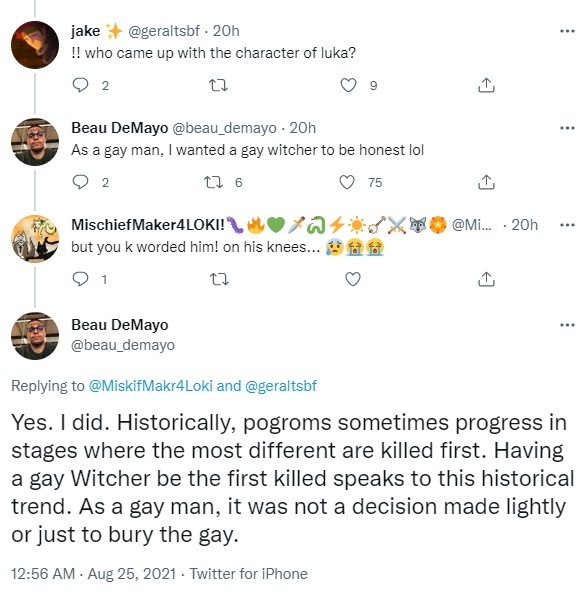
(image source: The Geekiary)
First, DeMayo explains of Luka’s creation that “As a gay man, I wanted a gay witcher to be honest lol,” which, fair enough! When another reply on Twitter points out, “but you k worded [killed] him! on his knees…,” DeMayo writes:
Yes, I did. Historically, pogroms sometimes progress in stages where the most different are killed first. Having a gay Witcher be the first killed speaks to this historical trend. As a gay man, it was not a decision made lightly or just to bury the gay.
It’s clear from his replies that DeMayo gave the matter of Luka a lot of thought and felt personally invested in the character. And he’s not incorrect about the history of pogroms. Though most closely tied to violence against Jews throughout history, a pogrom is a riot that generally results in the massacre, persecution, or expulsion of a religious, ethnic, or otherwise defined group. In 2017, a violent roundup of gay men in Chechnya was widely described as an “anti-gay pogrom.”
If you’re surprised to see the word “pogrom” in context with a fantasy realm that features basilisks, it’s actually applied via several events in the world of The Witcher. Author Sapkowski’s native Poland is reflected in various ways throughout the books, from folklore to its fraught history, and themes from the Central European past at large are interwoven with the text. In the novels, humans are the colonizers on the Continent, persecuting and exterminating the nonhuman species that lived there first. Other nonhumans are forced to live in ghettos and as second-class citizens.
What happens to the Witchers at Kaer Morhen in the books is described as a pogrom—complete with a hate-filled text that incited hatred of Witchers and is reminiscent of The Protocols of the Elders of Zion anti-Jewish propaganda (not to mention the Malleus Maleficarum, which spurred European witchhunts). From The Witcher wiki:
The dwindling number of monsters, together with vile acts committed purportedly by witchers and reported in Monstrum, or Description of the Witcher pamphlet, resulted in anti-witcher sentiments growing amongst Kaedwenian population. In 1170s a mob of peasants led by opportunistic mages stormed Kaer Morhen massacring everyone inside—23 witchers and forty students, including children, and the renegade mages who oversaw the mutation process. Only those of the Wolf School members who remained outside the castle survived. The pogrom was officially condemned as an “isolated incident”, with some of the attackers even expressing regret.
Mention of the slaughter of specific groups—especially the Elves—arises several times in The Witcher: Nightmare of the Wolf, and it’s shown that people are whipped into a murderous frenzy at the Witchers for crimes both real and imagined, and because the Witchers are different. At one point during the climactic battle, a character loudly protests that this is genocide.
But just as many of us are unaware of our own world history, many viewers watching Nightmare of the Wolf will not make the connection that the attacks against the Witchers are supposed to demonstrate a targeted, prejudiced massacre rather than just a messy fantasy final stand, complete with supernatural creatures and much spell-work.
As such, it’s difficult to see Luka’s hasty death as making an impactful statement about the persecution of those “most different,” in pogroms, especially because, as we’ve established, it wasn’t as though his identity was writ bold in the first place. If it’s never really confirmed and remains unclear to the audience, what we’re left with is a particularly senseless and ugly death reserved for the Witcher who seems queer-coded.
If the intent here was to show a pogrom against Witchers coming for the queer Witcher first, that should have been so much a part of Luka that fans wouldn’t be debating his sexuality online and needing clarification from the screenwriter.
And it would have been easy to do so: Luka could have spoken about a past relationship in non-joking terms. He could have been shown kissing a man in that fateful tavern scene. In fact, in that tavern scene, Luka and Vesemir are entertaining two women with tales of their exploits. Would it have been so difficult to have one of those listeners be a man, and Luka’s arm around him?
Ultimately, for most people watching, Nightmare of the Wolf is a bloody, entertaining bit of Witcher lore that fills in some background before The Witcher season two. The animation, from South Korean studio Studio Mir, is dynamic and bold in scope, allowing us to see fantastical elements of the Continent even the best live-action special effects cannot render. In 83 minutes, the brisk script makes us care about several characters and drives home the unique horrors of this universe.
But it’s 2021. If we’re going to have queer characters, they should be queer beyond jokey winks or having to consult creatives about their intentions thereafter. If we’re using them to teach lessons about our own horrible histories, let’s not tiptoe around the matter. It’s also more than time to meet queer characters in major properties who are leading happy, unabashed, and fulfilling lives, and not have them be an example of anything more than that.
(image: Netflix)
Want more stories like this? Become a subscriber and support the site!
—The Mary Sue has a strict comment policy that forbids, but is not limited to, personal insults toward anyone, hate speech, and trolling.—



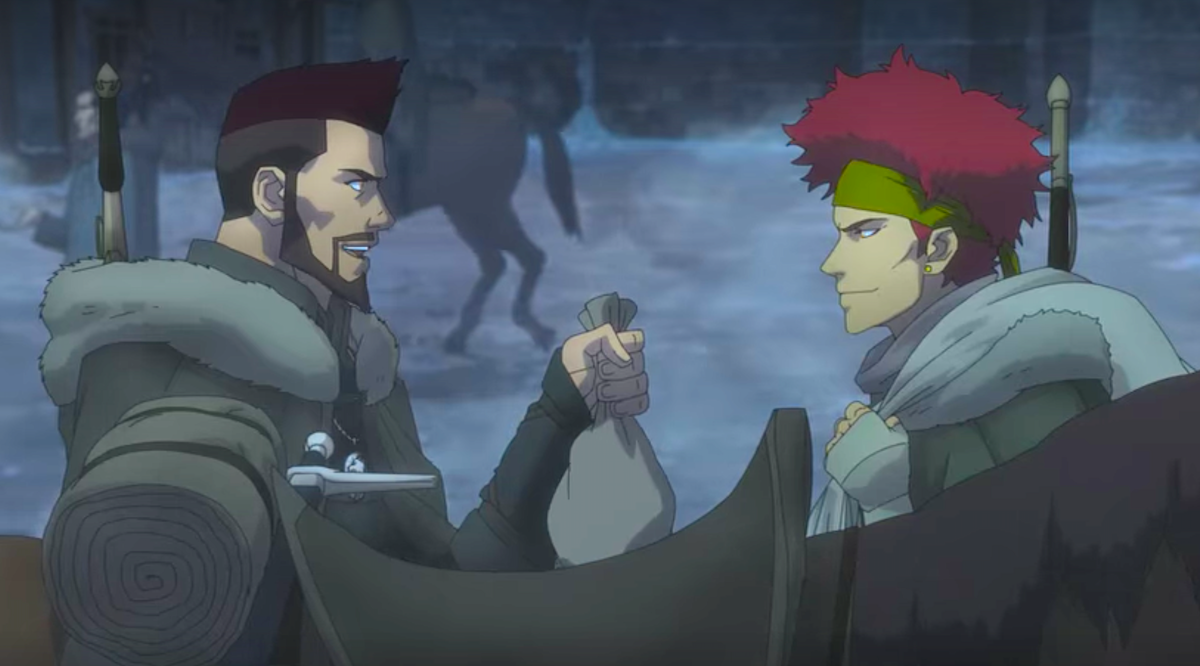

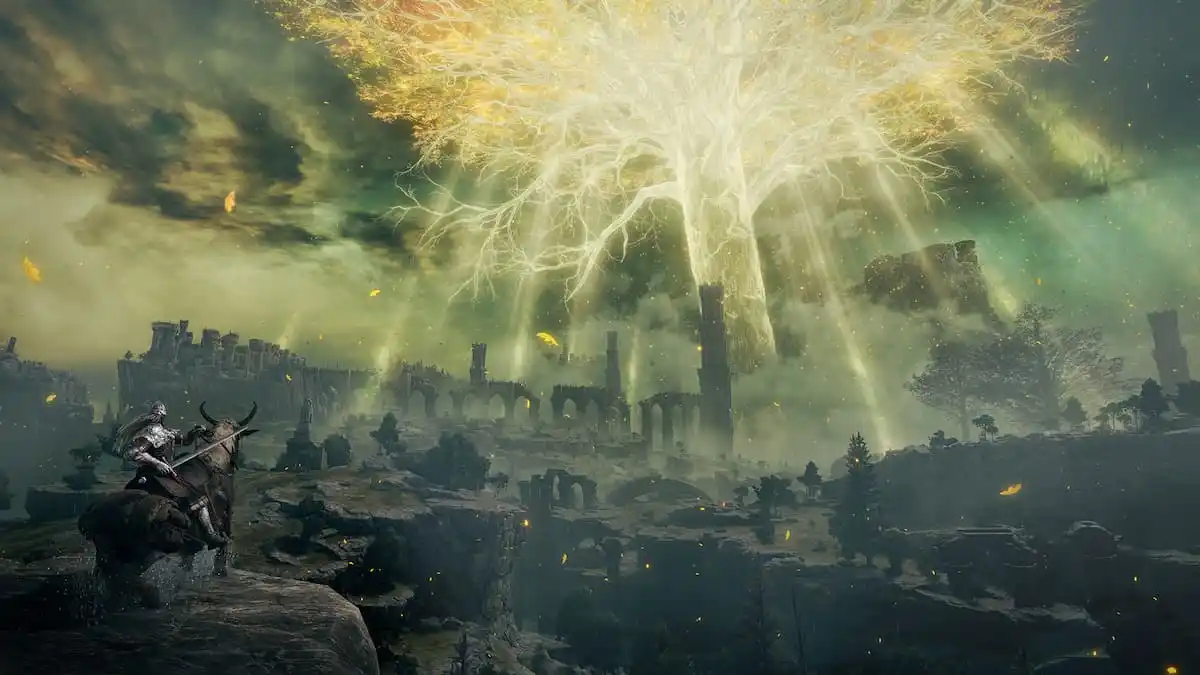
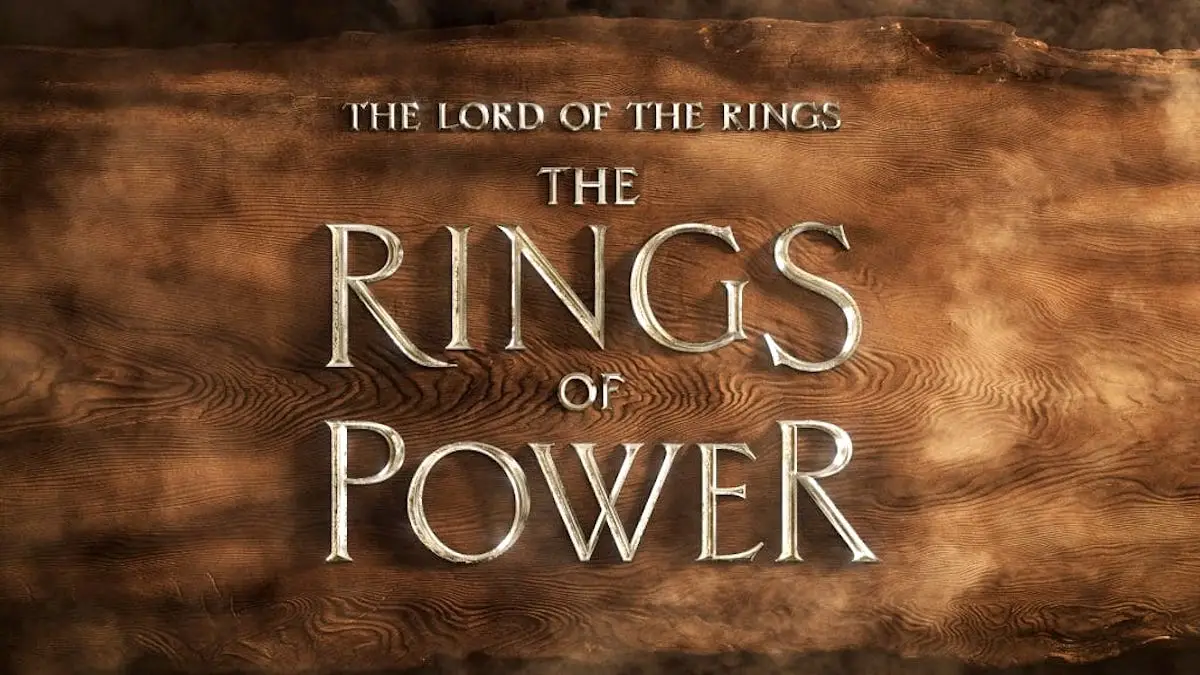
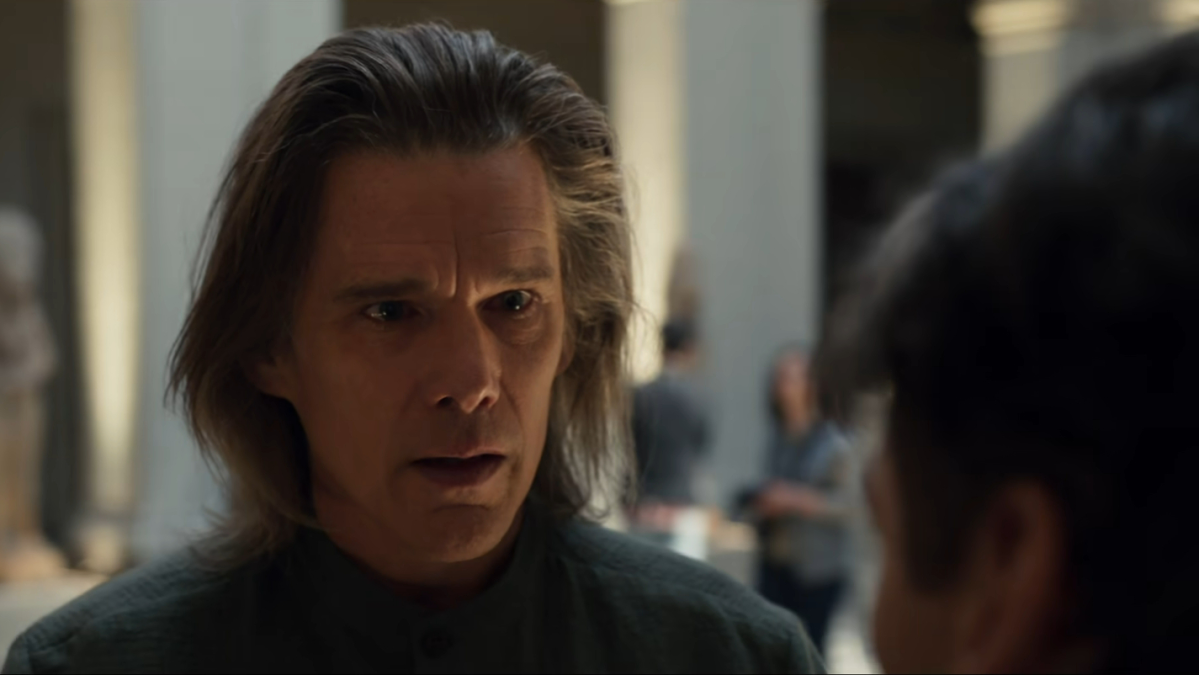
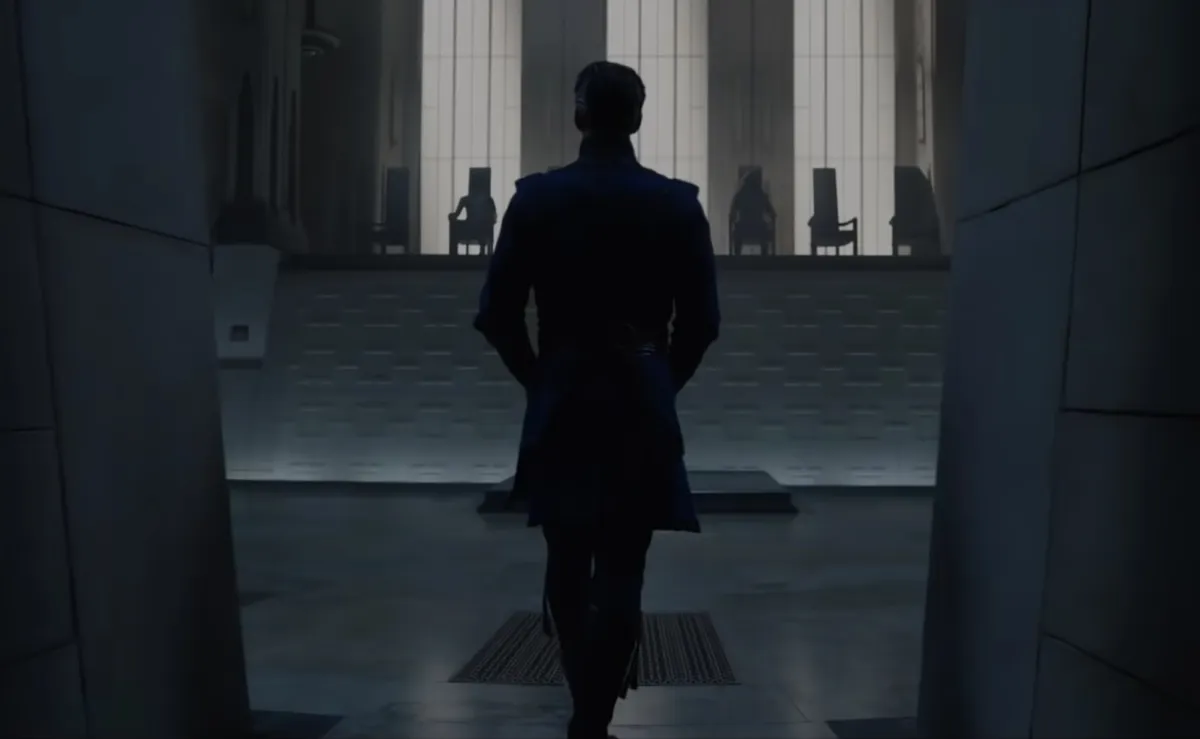

Published: Oct 12, 2021 03:54 pm